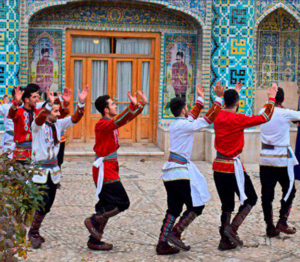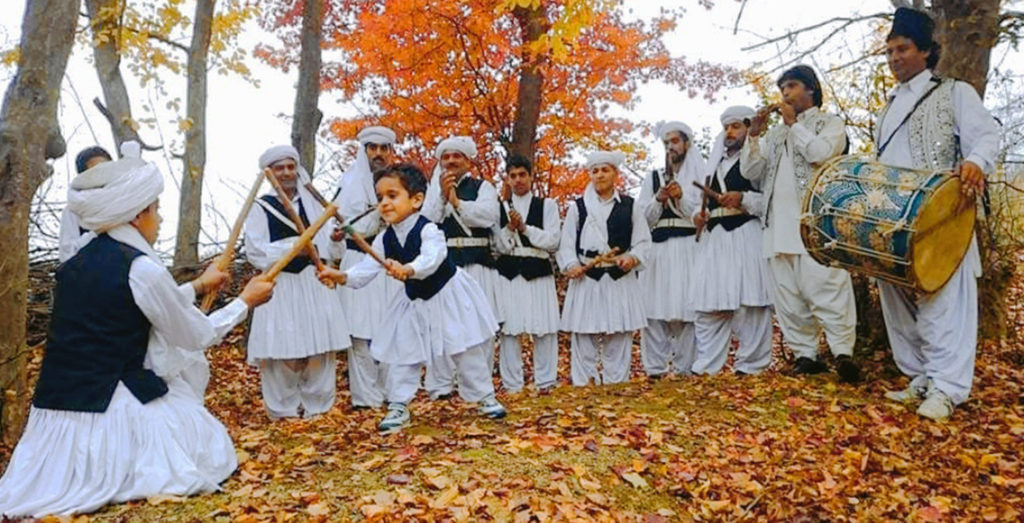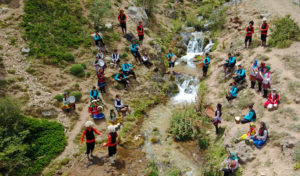Standing Their Ground: The vitality of Iran’s regional troupes - Vancouver Ballet Society
- Home
- Features 2020 - 2023
- Standing Their Ground: The vitality of Iran’s regional troupes

By Mahsa Hojjati
Editor’s Note: With the recent unrest in Iran that has echoed around the world, we considered holding back this story. However, we are going ahead. As the writer says on her Instagram page, “I feel that each step I am fortunate to take is not separate from the collective desires of all Iranians to speak, to move, to express ourselves and to participate in the cultural lives of our communities in Iran and across the diaspora. We need to keep moving — without ignoring the past or present — but keep moving nonetheless.”
~~
George Balanchine considered the folk dance of different countries a source for choreographic devices, since “they have done it all.” Balanchine’s words constantly come to mind during my travels in Iran, where regional folk dance troupes are impressive in their wealth of movement forms. Iranian dancers alone seem to have done nearly all.
Across Iran, social gatherings such as weddings are important occasions for dancing. Seven-day wedding celebrations were the norm two generations ago, but now they are typically distilled into a single day. On that day, the community dances for hours, endlessly repeating simple sequences that seem to effortlessly follow the music into the next set of movements. Occasionally breaking off from the communal flow, groups of virtuosos bust out with more challenging variations.
Folk troupes who perform their dances on stage tend to adapt one or more elements — spacing, formations, length of sequences, and sometimes even the speed of movement — in order to present their repertoire for an audience in the limited space and shorter durations of a theatrical stage presentation. Iranian troupes face an additional challenge. In Iran, for over four decades, women have been prohibited from dancing in public performances, so dance troupes are made up only of men. Women musicians are sometimes granted permits to play music for the dancers, but their own movement remains relegated to private or women-only spaces.

So, during my travels, I could only observe and interview male troupes at folk festivals across the country. However, through invitations to private festivities, I was able to learn movements from women who encouraged my participation. Over the years, it became evident that exclusion from performing groups did not mean that women had stopped or would ever stop dancing. On my most recent visit in May 2022 to the three men-only groups below, it was clear that women are a separated but vital contributing force.
Chiksay
The history of Kurmanji-speaking Kurds in North Khorasan, a province in northeastern Iran, stretches back over 400 years when they were forced to migrate from their homelands in the west. Their dances, which are distinct from western Kurdish ones, take the form of circle dances performed to traditional instruments, including the dāyereh (a frame drum) and qoshme (a double-piped, single-reed wind instrument). Based in the city of Bojnurd, Chiksay Group has presented Kurdish Kurmanji dances in countless national and international festivals in Türkiye, Georgia, and the Republic of Azerbaijan.

During an interview in Bojnurd with Chiksay’s founder and director, Hamed Matarānluei, he reminisced about their early years when the dancers did not have the support of friends and family. Elders advised Matarānluei (who is also a practicing architect) to follow conventional paths of work, but he never let go of his dream of forming a troupe which could take Kurmanji music and dances to stages that had been the stomping grounds of other regional dances for years.
While Chiksay’s troupe of 30 dress in traditional black pants, shāl (waist wrap), neckerchief, peytabe (shin wraps), and charoq (leather Kurmanji style shoes), they also innovate. The troupe’s shirts are embroidered with traditional techniques, but new designs transmit their nomadic history and the important role of strong women in their lives. Their symbolic representation of Kurmanji women, who are not permitted to perform with them publicly, is also innovative. In performances, half the troupe wears the customary white colour for women, instead of all of them wearing men’s traditional red.
Regarding innovation, Matarānluei says, “In order to perform our dances truly, a knowledge of history, culture, rhythms, and the recognition of appropriate music to specific types of movement is necessary.” He believes changes they make themselves, rooted to a knowledge of their culture, are natural, whereas changes that others make can be damaging to their dances. Folk dancers abroad, who have not learned directly from Kurmanji musicians and dancers, might be able to produce costumes with relative ease, but movements distanced from method and meaning often turn into misrepresentation of a culture they have not experienced first-hand.
Watching Chiksay perform the introductory dance called hange khānān in Tehran, I try to silently name each variation of fingers, wrists, lower and upper arms as they flash through seemingly effortless sequences. My exercise feels rather like a tongue-twister. As the dances become increasingly complex, I look for the characteristic movements of each style. Pulsing crouches and running half-turns in chap-o- rāsteh, leaps and lunges in lari lari, and martial movements of the danced rituals of chub bāzi are examples of a rich movement vocabulary steeped in history and still relevant today.
In the last year, Chiksay initiated a children’s group, where seven-to-12-year-old girls learn dances along with boys. In their children rests Chiksay’s wish: for their music and dance to stretch into a future that will retain the historical ability of Kurmanji Kurds to stay strong and vibrant despite adversity.
Zendegi
Before the pandemic, tourists often visited Sari, the capital city of the province of Mazandaran, where Zendegi Group welcomed them with Mazani music and dance as they stepped off the train. True to their name, which means life, Zendegi has a reputation of enlivening crowds at countless national festivals. So it was no surprise that as the pandemic seemed to calm down in May 2022, the ten member countries of the ECO (Economic Cooperation Organization) chose Sari as the cultural capital for the annual international ECO festival.

Zendegi was founded over 20 years ago by renowned poet and scholar of Māzani culture, Ali Hassannejad. On the day I visited Zendegi for the Iranian pre-New Year tradition of Noruz Khāni, celebrated as a city parade in Sari, an excited crowd surrounded them. We followed the beats of countless percussion instruments through the bustling streets where traditional Māzani clothing formed a river of colour. Sounds of wind instruments floated through the air.
Before the parade, I had been invited to a private meeting of a women’s collective. Vital to the 20-member troupe, Zendegi’s female musicians accompany most of their presentations, but only indoors could I see women perform the dances that men would display during the parade. I delighted in watching yevari semā (sequences where hip and leg movements turn the body around the opposite pivoting foot) and devari semā (alternate step-touch sequences). They also danced dori, where partners mirror each other’s movements as they draw closer. Hip isolations and knee bends, some slight, some much deeper, are also characteristic of Mazani dances.
During three nights of the ECO festival, various groups performed folk music from west to east Mazandaran, but it was Zendegi that brought the festival inauguration to life with chakke semā dances and their accompanying joyous kalli (high-pitched hoots). While alternate step, ball, step is basic footwork across linguistic groups in Iran, chakke semā uses a distinct posture for these steps. With heads tilted, straight backs, and slightly bent at the waist, dancers move with unique spins and claps, crouches and jumps, connected to past lifestyles as both highlanders and rice harvesters.
One of the dancers performed the popular estekān (tea glass) dance, a solo during which he accented varied movements while clapping two tiny tea glasses together in each hand. The dance features hip work, alternate sliding steps, and balancing movements where one ankle rests on the opposite bent knee.
Long ago Mazani families used to sing comic courtship songs in weddings; some men wore skirts, representing the bride, while others represented the groom. Zendegi revived the wearing of shele shelvār (flouncy skirts) over traditional pants for portions of their chakke semā presentations in order to display the dances women traditionally do, but cannot perform publicly.
Hassannejad is firmly dedicated to teaching youth. He believes learning traditional regional music and dance builds children’s self-confidence and connects them to their community. If his students decide to innovate someday, their paths will be deeply rooted to a knowledge of their history and culture through their spoken, musical, and movement languages.

Hamoon
In Gorgan, the capital city of Golestan, I met with Mohammad Nuri, the director of Hamoon Sistani Group. He made me promise I’d start any description of Hamoon with an appreciation of their mentor, Mohammad Shahi Pudineh, a prize-winning photographer and a tireless promotor of Sistani culture at the Ministry of Cultural Affairs of Golestan province.
The division of the Hirmand river between Afghanistan and Iran over 100 years ago, ill-planned dams, and the subsequent drying-up of Lake Hamun during drought years pushed large numbers of Sistanis to migrate north from their ancestral lands to Golestan province over the past 90 years. So Hamoon’s presence in numerous national festivals has been instrumental in increasing visibility for Sistani music, dance, and customs.
At their performance at the Niyavaran gardens in Tehran during a visit in March, I marvelled at the variety of their dances. The dohol (a double-headed drum) started slow for the alternate turns in chāp and gently picked up speed for the faster jumps and half turns of se chāp. The endless spins of sar-e yek lengakā followed faster rhythms that soloists took turns performing. The grand finale was dedicated to the danced rituals of choveh and dochoveh, rooted to Sistani martial arts of the past.

Two months later, accompanied by my daughter, I set out to meet the troupe of 14 in an out-of-town bagh (orchard) near Gorgan. As the taxi drew near, my spirits soared with the sounds of the sornā (a double-reed instrument) and my heart thumped to the beat of the dohol, which they played to welcome our arrival. We greeted each other, surrounded by music that seemed to strengthen bonds formed on previous visits.
In the bagh, the women coaxed my daughter and I into a quaint cabin and dressed us up in brightly coloured Sistani tunics, vests, and long gathered skirts. I needed no coaxing to join them in dancing. Pleased beyond description, I accompanied several women in the fluid movements of chāp and se chāp circle dances that seemed to have no beginning and no end. As long as the music continued, it seemed natural to keep stepping and turning in harmony.
The next day, we returned to the bagh to continue our conversations as heavy clouds drew near. While warming ourselves near the cabin stove where a pot of abgusht (lamb stew) simmered slowly, the women described their traditions: from past lifestyles, clothing, food, and crafts to ceremonies, songs, and dances.
We met a third day as well, until all their stories had been told, and what remained was the desire to see each other again in a future where we can sing and dance together freely. The blessing of rain that we received, as we parted ways, gave me hope that such a future could be cultivated.

